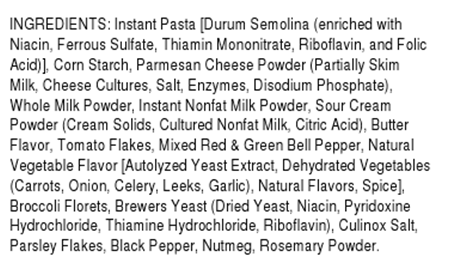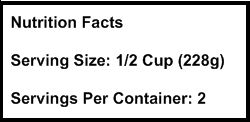Why sacrifice a decent meal when you are on the trail? Eating well on the trail tastes better and gives you the right types of food to enhance your performance and give you the gusto to go a little further. Eating well does not have to be gourmet or cost a fortune. Learn how to compare packaged foods to determine if the meal is worthy of stashing in your pack for your next outing. Start by following these tips.
Should I buy this common backpacking meal? The product displays the following ingredients:

1. Decode the Ingredient List
Here is an analysis of the ingredients from the above backpacking pasta dish.
- Enriched – means it is not whole grain, aka a simple carbohydrate (sugar), because it has been processed to strip off the nutrient and fiber-rich parts of the plant. The ingredient’s origin (in this case, durum wheat) is processed to remove the bran and germ to allow instant cooking and a milder taste. Since refinement processing eliminates the plant’s original nutrients, some vitamins are “enriched” (added synthetically) to prevent known nutritional deficiencies. The synthetic nutrients added back to the food must be listed. In the photo above, these five are niacin (vitamin B3), ferrous sulfate (iron), thiamin mononitrate (vitamin B1), riboflavin (vitamin B2), and folic acid (vitamin B9). While these additives help lessen the impact of consuming refined food, they are an inferior substitution. Some packages will declare “enriched” for grains, but you can tell if it is enriched/refined if the substances are listed in parenthesis next to the grain.
- Butter Flavor – One form of artificial butter flavor is the chemical diacetyl (most common in microwave butter popcorn), which is reportedly a cause of respiratory problems when inhaled.
- Autolyzed yeast extract is another name for monosodium glutamate or MSG. Other words to describe glutamates added to the food include hydrolyzed vegetable protein and autolyzed yeast extract.
- Natural Flavors – this can mean just about anything approved for use in food. The exact definition of natural flavorings & flavors from Title 21, Section 101, part 22 of the Code of Federal Regulations is as follows: “The term natural flavor or natural flavoring means the essential oil, oleoresin, essence or extractive, protein hydrolysate, distillate, or any product of roasting, heating or enzymolysis, which contains the flavoring constituents derived from a spice, fruit or fruit juice, vegetable or vegetable juice, edible yeast, herb, bark, bud, root, leaf or similar plant material, meat, seafood, poultry, eggs, dairy products, or fermentation products thereof, whose significant function in food is flavoring rather than nutritional.”
- Spice – any dried edible herb or seasoning. Look for products that disclose the actual spice name rather than hide it under the blanket term.
- Corn Starch – an inexpensive thickener added in many packaged foods to prevent sticking and thickening.
What about this packaged noodle dish?

First, notice all the sodium? Wow! Here is an analysis of the ingredients.
- Enriched Wheat Flour – means it is not whole grain aka a “white flour” food, a simple carbohydrate. Promotes diabetes, obesity, nutrient loss.
- TBHQ – Tertiary Butylhydroquinone. Petroleum-derived butane used alone or in combination with butylated hydroxyanisole (BHA) or Butylated hydroxytoluene (BHT). Promotes cancer.
- Hydrogenated Soybean Oil – use of hydrogen gas to solidify liquid oil at room temperature. Reduces spoiling and enhances flavor. Contains MSG. A trans-fat. Promotes heart disease.
- Food Starch Modified – ordinary starch chemically altered for thickening. Common thickening chemicals include propylene oxide, succinic anhydride, aluminum sulfate, sodium hydroxide. A top priority for the FDA to reevaluate since 1980. No updates since.
- Monosodium Glutamate – MSG. The monosodium salt of glutamic acid, an amino acid. Occurs naturally in seaweed, soybeans, and sugar beets. Even if a manufacturer tells you there is no MSG in a product, there may be “natural MSG” additives, such as autolyzed yeast, flavors & flavorings, yeast extract, hydrolyzed protein, hydrolyzed soy protein, plant protein extract, protease, and other ingredients that create processed free glutamic acid (MSG) during manufacture. Synthetic MSG is known to cause brain damage in test mammals. It causes mood changes, headaches, hormonal disorders, chest pain, and digestive problems in many people. A possible contributor to obesity because it confuses the brain and promotes overeating.
- Hydrolyzed Corn – see Monosodium Glutamate
- Autolyzed Yeast Extract – see Monosodium Glutamate
- Artificial Flavor – Flavoring substances not identified in a natural product intended for human consumption. Produced by chemical manipulation from sourced chemicals, such as crude oil or coal tar.
- Disodium Inosinate – a flavor potentiator (additive) used in combination with MSG. A flavor potentiator increases “perceived intensity” of the flavor of another substance.
- Disodium Guanylate – a flavor potentiator (additive) to provide a sensation of “fullness” and “increased viscosity” when eating.
2. Know that “Serving Size” is Arbitrary
Serving sizes differ on each food label and are probably much lower than the actual serving size you eat daily (2-4x what you would eat backpacking). Consider the Total Servings per container, which should disclose the amount in cups, to determine if the meal is adequate.

Is 1 cup serving size enough food for two people, let alone one? When you compare brands, compare the total servings per container rather than the serving size.
3. Check Calories Per Weight
Calories count when backpacking, so pay attention to the amount. Caloric requirements for backpacking are high, from 3000 to 6000 per day. To meet those requirements, only look for products with a minimum of 100 calories per ounce. Backpacking meals can often include a condiment sachet, such as olive oil, canola oil, mayo, parmesan cheese, etc. Make sure you know if those count as part of the stated calories of the meal.
4. Review the Nutritional Panel
Check the product’s nutrient details. Backpackers should get a majority of their calories from carbs and fat — the two preferred fuels for hiking.
- Carbs – make this the majority of calories. Complex carbs are best.
- Fat – make this the secondary source of calories. Unsaturated fat is best.
- Protein – make this the least amount of calories. Plant sources are best.
- Sodium – stay around 2,400 milligrams per day. Add more salt if you will be sweating heavily.
Carbohydrates should make up the most calories because carbs provide the body with immediate energy needs. Choose wholesome carbohydrates –
- Fruits, vegetables, beans, and whole grains.
- To find what is a whole grain, look for the word “whole”. A product marketed as multi-grain or wheat is not whole unless the word “whole” appears in the ingredient list.
Fats are the body’s second preferred energy source and should make up the second most majority of calories.
- Choose healthy unsaturated fats
- Limit saturated fat (animal products)
- Avoid trans fats (margarine, shortening, hydrogenated fats). Partially hydrogenated oils are the primary source of trans fats, which are more harmful to arteries than saturated fat. Too much fat builds up in the arteries and puts a strain the heart. Trans fats are often found in cakes, cookies, candy bars, crackers, donuts, muffins, fries, and margarine.
Protein should make up the least calories, 10 – 15% of total calories. Protein does not provide energy; it is used by the body for DNA construction, or to build new cells (muscle & tissues).
- Don’t buy into the scam of protein bars, protein shakes, etc. Excess protein is digested as a carbohydrate with extra water required to remove nitrogen waste. The excess is not used in the body and passed straight out in the next bowel movement.
Sodium requirements increase when backpacking, but not that much. Try to stay close to the range of 2,400 mg per day.
Sources of sodium –
- Baking powder
- Baking soda
- Brine
- Disodium phosphate
- Miso
- Monosodium glutamate (MSG)
- Salt
- Sodium alginate
- Sodium benzoate
- Sodium bisulfate
- Sodium propionate
- Soy sauce
5. Consider the Packaging
Check the packaging and weight. Is this something you will have to repackage at home, and if so, how easy will it be to do? If the meal is meant for long-term storage or backpacking, is it packed in a foil-laminated poly-gusseted pouch? This type of packaging is intended for durability but is heavy and not recyclable.
6. Non-disclosed Chemical Contaminants
Ingredients lists don’t have to list the chemical sprays used to grow plants or feed animals. Look for organic ingredients to avoid chemical additives.
3 thoughts on “Comparing Backpacking Meals”
Thanks for writing this guide. I’ve been researching a healthy diet for thru-hiking but have only found junk so far. How come almost EVERY single person lists “Snickers” on their food list? It’s baffling. I know there is a healthy way to survive out there without resorting to junk food 24/7. I’m envisioning things last whole-wheat pastas with canned butter beans, pancakes, fresh fruit even, after town stops etc.
Hahaha – agreed on the interesting things people bring or swear by when thru hiking….about your comment above though, because Snickers are ridiculously delicious at the end of a daunting day! You’ll be surprised of the mental and taste bud relief of some of the sweet items people list….it is mainly for sanity and dessert purpose, not truly for a nutritious snack. We had trail angels stop by one night and give us Snickers and watermelon. We saved the Snickers for the next day and all of us were SO HAPPY we’d grabbed one. But, agreeing with you as well that some people do resort to high sugar/cal type foods and in the long run that likely is not making your body perform and what it could with healthier fuel.
This whole site is excellent. So glad I found you through a reference in Backcountry Foodie.